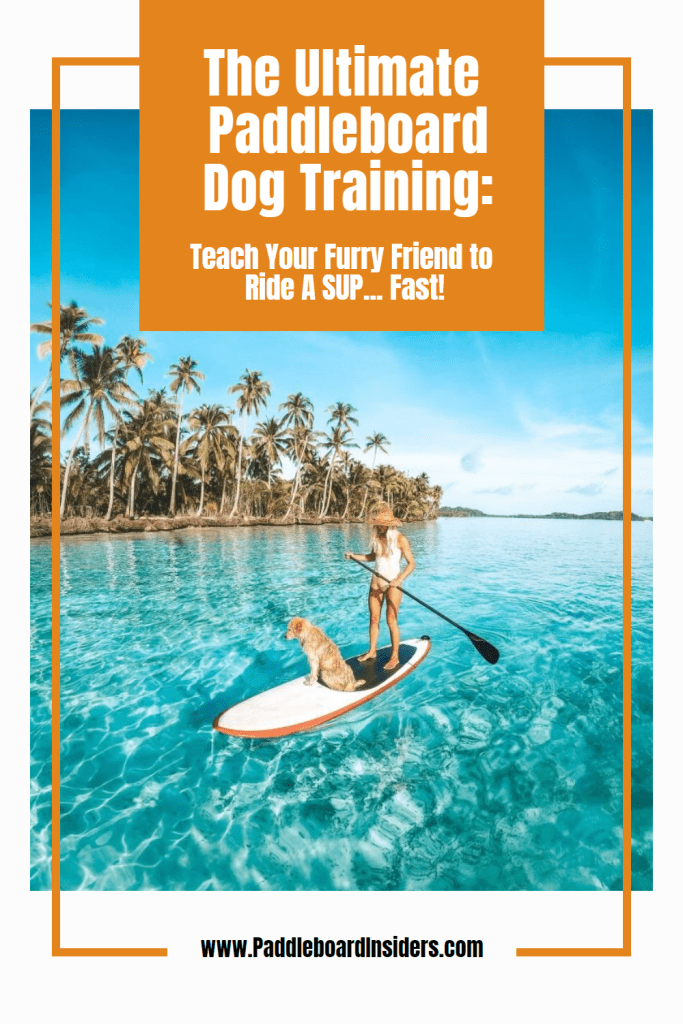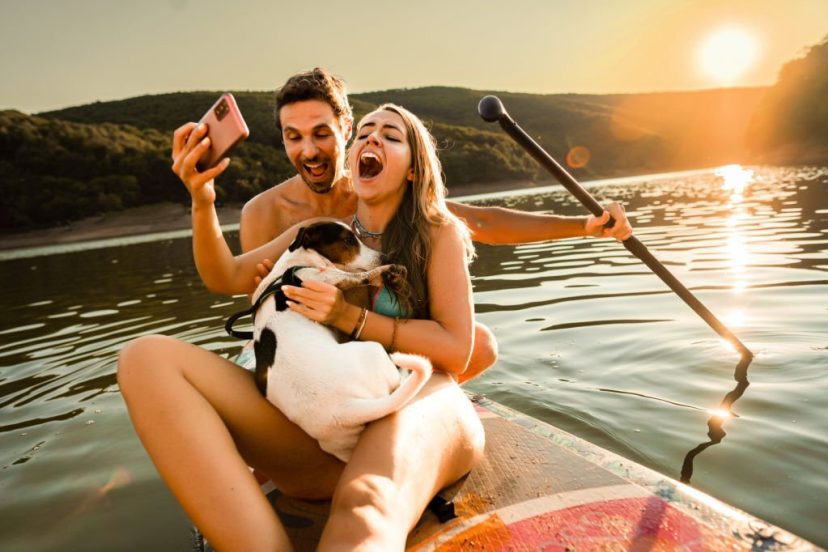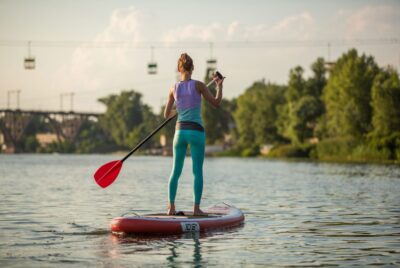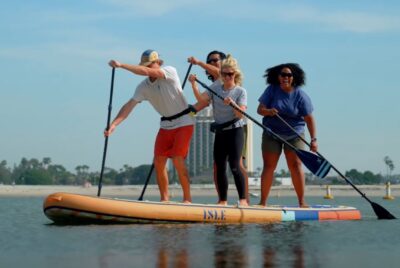The Ultimate Paddleboard Dog Training: Teach Your Furry Friend to Ride A SUP… Fast!
*We may earn a commission for purchases made using our links. Please see our disclosure to learn more.
Paddleboard dog training… I never thought that I’d be writing this article until I actually tried it!
And let me tell you… Having a SUP with your pup is AMAZING!
What could be more enjoyable than sharing a paddleboard dog adventure with your four-legged companion?
Paddleboarding with your dog not only allows you both to soak up the sun and enjoy the water but also strengthens the bond between you. And not only that but it allows you to go on so many different adventures all around the world with your pup.
In this article, I’ll guide you through the process of paddleboarding with your dog, providing helpful suggestions and reasons for each step.
| Looking for our best paddle board product recommendations? Check the Paddleboard Insiders Buyer Guides |
Table Of Contents
- THE BEST EQUIPMENT TO PADDLE BOARD WITH YOUR DOG
- The Best Inflatable SUP For Paddleboard Dogs:
- Other Essential Accessories For A Paddleboard Dog:
- HOW TO INTRODUCE YOUR PUP TO THE PADDLEBOARD
- HOW TO PREPARE FOR YOUR PADDLEBOARD DOG ADVENTURE
- HOW TO GET YOUR DOG OUT ON THE WATER
- ESSENTIAL SAFETY TIPS FOR EVERY PADDLEBOARD DOG
- FAQs (Frequently Asked Questions)
THE BEST EQUIPMENT TO PADDLE BOARD WITH YOUR DOG
Before hitting the water, it’s essential to ensure you have the right equipment.
The Right Paddleboard:
You want to look at boards that offer enough stability, deck pad space and durability when doing paddleboard dog training. All of these factors are going to play a major role in determining how fun your experience is for you and your dog.
Stability: You need to understand that your dog WILL shift their weight around, so you must focus on using a wider and stabler SUP (33″ or 35″ is what you want).
Space: This might be obvious but it’s not just you on the SUP this time, that’s why you want something that has a bit more space on it without D-rings or any mounts (this can hurt your pup).
Durability: Finally you want a dog-friendly paddleboard because your pup might be nervous and will try to use their claws to hold onto the board which can destroy low quality deck pads. They also use their claws when jumping back on the board so it’s essential to have a good deck pad on your SUP.
With that being said, you DON’T want to be using a low-cost paddleboard because it will likely be destroyed by your pup.
The Best Inflatable SUP For Paddleboard Dogs:
* Roc Inflatable SUP (Best Budget SUP For Dogs)

Where To Buy: Amazon
Why I Love It:
– Has a large non-slip comfort deck that can easily fit you and your paddleboard dog.
– Extremely high quality material that won’t get scuffed and damaged by your pups claws.
– 16.25 inch width makes it very stable
– It was designed with pets in mind!
* Portal 11’6″ Paddle Board (Best Overall SUP For Dogs)
Where To Buy: Amazon
Why I Love It:
– 33 inch width gives it amazing width and stability.
– It has a depth of 6 inches that increases the weight capacity of the board to over 300lbs without sacrificing stability.
– This board has ample space along with a non-slip deck pad that is perfect for your paddleboard dog.
– It comes with everything included and a 2 year warranty.

* MYBOAT 11’6″Extra Wide SUP (Best Full Length Deck)

Where To Buy: Amazon
Why I Love It:
– This board is extra long and extra wide which is ideal for beginners and dogs (because it’s super stable)
– This board was designed yoga which has similar requirements to pets (space and stability)
– It has ample space along with a ridged deck pad that will have your pup feeling at home
– It comes with everything included and a 1 year warranty.
If you already have a board then here are some other essential accessories to protect your board (and pup)
Other Essential Accessories For A Paddleboard Dog:
* Punt Surf Non Slip Traction Mat
Where To Buy: Amazon
Why I Love It:
– It has great traction and cushioning for your dog. It gives them traction without hurting them.
– This traction pad was designed for kayaks, SUP’s and surfboards so it can give you as much traction space as you need.
– It uses diamond grooved EVA foam which is super sticky in all conditions and you won’t slip.

* SUP- Now Paddleboard Dog Traction Pad

Where To Buy: Amazon
Why I Love It:
– This is a grip cushion for where your pup will stand.
– It has diamond grooves that have high grip and it uses 3M adhesives to protect your SUP and make sure that the pad stays in place.
– It’s 26″x 19″ which is big enough for even two dogs to lie down.
Where To Buy: Amazon
Why I Love It:
– It is comfortable and won’t ever hurt your dog.
– It comes in 6 different sizes and 7 different colors so that your pup looks great in the water
– Includes a quick release buckle that you can use to quickly release your pooch
– It’s actually EASY to clean!

Now that you have all the essential equipment for your paddleboard dog adventures, let’s talk about introducing your dog to the paddleboard.
HOW TO INTRODUCE YOUR PUP TO THE PADDLEBOARD
Paddleboarding can be an exciting adventure to share with your furry companion. However, the unfamiliarity of wearing a life jacket or standing on a paddleboard can be intimidating for your lovable pooch.
To ensure a smooth transition and a positive experience, follow these helpful tips to introduce your dog to paddleboarding before hitting the water:
Teach Your Dog The Basic Commands:
Before venturing onto the water, ensure that your dog has mastered basic obedience commands such as “sit” and “stay.” These commands establish a foundation of control and reinforce your role as the pack leader during your paddleboarding sessions.

Master Your Paddleboard Skills First:
It is essential to become comfortable using a paddleboard on your own before including your dog in the experience. Gain confidence in standing up, paddling, turning, and even falling off the board and getting back on. Dogs are highly perceptive and can mirror your stress levels. Being at ease on the paddleboard will create a more relaxed environment for both you and your dog.
Introduce Your Dog to the Paddleboard:
Before heading to the water, familiarize your dog with the paddleboard on solid ground. Place the board in an area of the house where your dog feels comfortable. You can put a dog toy for your specific dogs breed on the paddleboard so that it allows him to approach the board, sniff it, and explore it at his own pace. The goal is to create a positive association and a sense of familiarity with the paddleboard.
Use Treats to Encourage Them To Explore The Board:
Once the paddleboard has been introduced indoors, place treats on and around the board to entice your dog to walk on it. Use verbal cues such as “sit” and reward him with a treat for obeying.
Repeat this process, allowing your dog to gradually build confidence and associate the board with positive experiences. Patience is key—never force or pressure your dog onto the board.
Perform Dry Runs with a Life Jacket:
Once your dog is comfortable with the paddleboard, introduce him to wearing a properly fitted life jacket. This step prepares him for the gear he’ll wear during actual paddleboarding sessions. Encourage your dog to get on the board while wearing the life jacket, reinforcing the idea that it’s a safe and enjoyable experience.
Practice Commands for Getting Off the Board:
Before heading to the water, establish a special command for your dog to jump off the paddleboard. Reward him only when he follows the command to reinforce desired behavior. If your dog jumps off without the command, guide him back onto the board and try again. Consistency and repetition will help your dog understand the command.
Reward Good Behavior:
During your paddleboarding sessions, encourage your dog to jump off the board only when commanded. Reward him with treats or praise when he follows the command. By doing so, you can prevent unwanted jumps, especially when nearing the shore, which may destabilize the board and compromise safety.
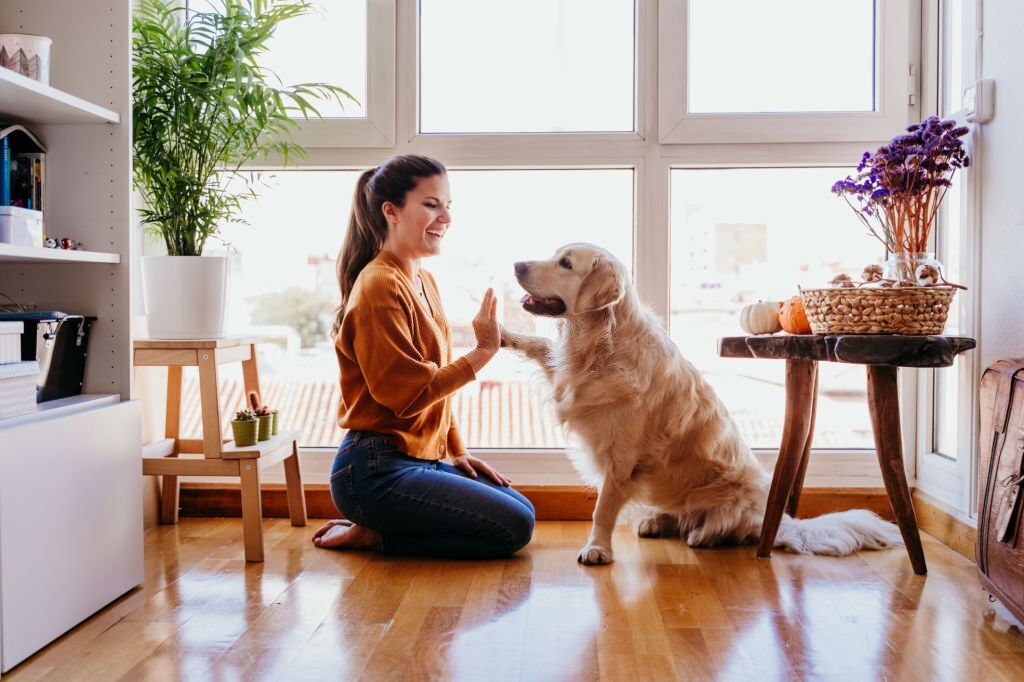
By following these step-by-step guidelines, you can ensure a smooth and positive introduction of paddleboarding to your dog. Remember, every dog is unique, so adapt the process to suit your dog’s individual needs and pace.
With patience, consistency, and positive reinforcement, you and your furry friend will be ready for unforgettable paddleboarding adventures together.
HOW TO PREPARE FOR YOUR PADDLEBOARD DOG ADVENTURE
Here are some key considerations before embarking on your SUP adventure with your new paddleboard dog:
Assess Your Dog’s Swimming Ability:
Before taking your dog paddleboarding, it’s crucial to ensure that they are comfortable and confident in the water. If your dog is a weak swimmer or fearful of water, it’s recommended to provide swimming lessons or consult a professional dog trainer for guidance. Familiarizing your pup with swimming beforehand will enhance their overall enjoyment during the paddleboarding experience.
Trim and Maintain Nail Length:
To protect your paddleboard and prevent any accidental damage, it’s advisable to regularly trim your dog’s nails. Shorter and duller nails reduce the risk of scratching the board’s finish or tearing the deck pad while your dog moves around on the SUP. Regular nail maintenance is key to preserving the board’s longevity.
Bring Treats for Positive Reinforcement:
Rewarding good behavior is essential in training your dog to become a well-behaved paddleboarding companion. Bring along a pocketful of treats to reinforce positive actions during your adventure. For instance, if your dog tends to jump off the board without permission, you can use treats to redirect their behavior and gradually train them to be a more obedient passenger over time.
Exercise to Drain Excess Energy:
Energetic dogs may find it challenging to stay still on a SUP, potentially affecting your balance and stability. To minimize this issue, engage your dog in vigorous physical activity before the paddleboarding session. Play a game of fetch or allow them to swim and expend their energy. A tired dog is more likely to remain calm and relaxed on the board, contributing to a smoother and safer experience for both of you.

By following these preparatory steps, you can ensure a safer and more enjoyable paddleboarding experience with your beloved canine companion. Remember, each dog is unique, so take the time to understand their individual needs and comfort levels in the water.
HOW TO GET YOUR DOG OUT ON THE WATER
Paddleboarding with your dog can be a thrilling and enjoyable experience for both of you. However, it’s crucial to prioritize safety and take the necessary steps to ensure a smooth and successful outing. Here’s a step-by-step guide to help you paddleboard with your dog in a safe and enjoyable manner:
Step 1: Introduce the Fun:
Begin by making paddleboarding an exciting and positive experience for your dog. As you head out on the board, wave, laugh, and smile, showing your dog that it’s a fun adventure rather than something scary or intimidating.
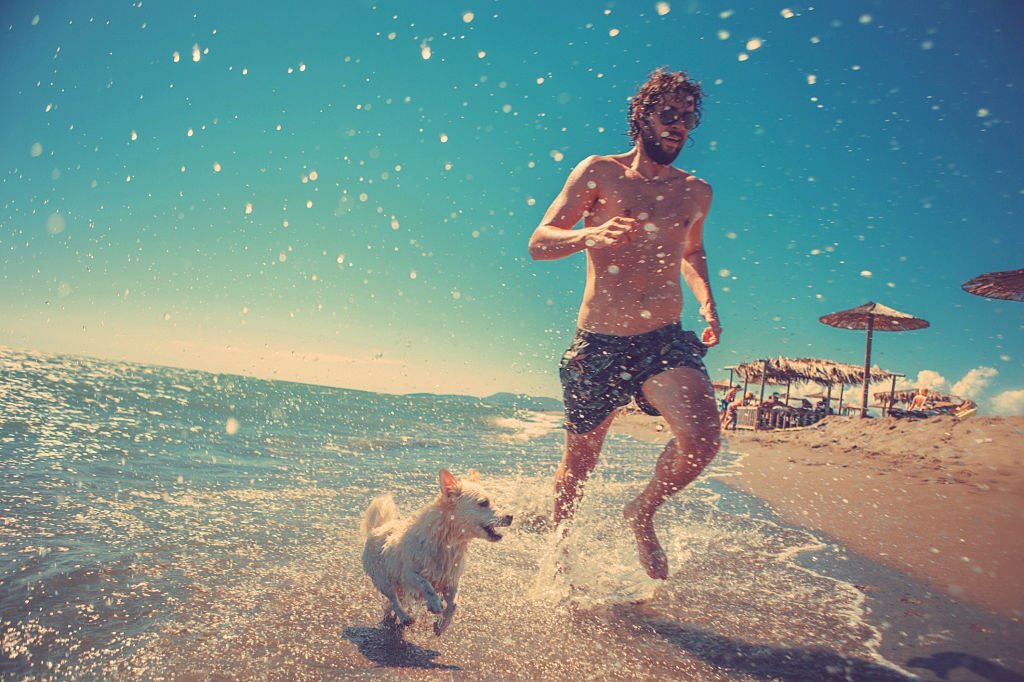
Step 2: Shore Preparation:
Keep your dog on the shore initially while you familiarize yourself with the paddleboard. This gives you an opportunity to make any adjustments and get comfortable before inviting your furry friend onto the board.
Step 3: Gradual Acclimation:
In shallow water, hold the board steady and allow your dog to get on if they feel comfortable. You can walk alongside the board, giving your dog the freedom to jump off if they wish. This step helps them associate the board with positive experiences.
Step 4: Start on Your Knees:
When both you and your dog are ready, get onto the board together. Begin paddling on your knees to ensure better balance and stability, allowing you to adjust to the motion of the water.
Step 5: Standing Up:
Once you feel confident and balanced, transition to a standing position on the board, with your dog either between your feet or slightly forward. Take care to paddle without accidentally hitting your dog with the paddle. It may take a bit of practice to master this technique.
Step 6: Positioning for Different Sizes:
Depending on your dog’s size, there are specific positions on the board that provide better weight distribution and balance. Small dogs can sit on the nose of the board, while larger dogs should sit on the back third of the board.
Step 7: Start with Short Sessions:
Keep your initial paddleboarding sessions short to prevent your dog from becoming overwhelmed or fatigued. When you return to shore, reward your dog with praise and treats, reinforcing the positive experience.
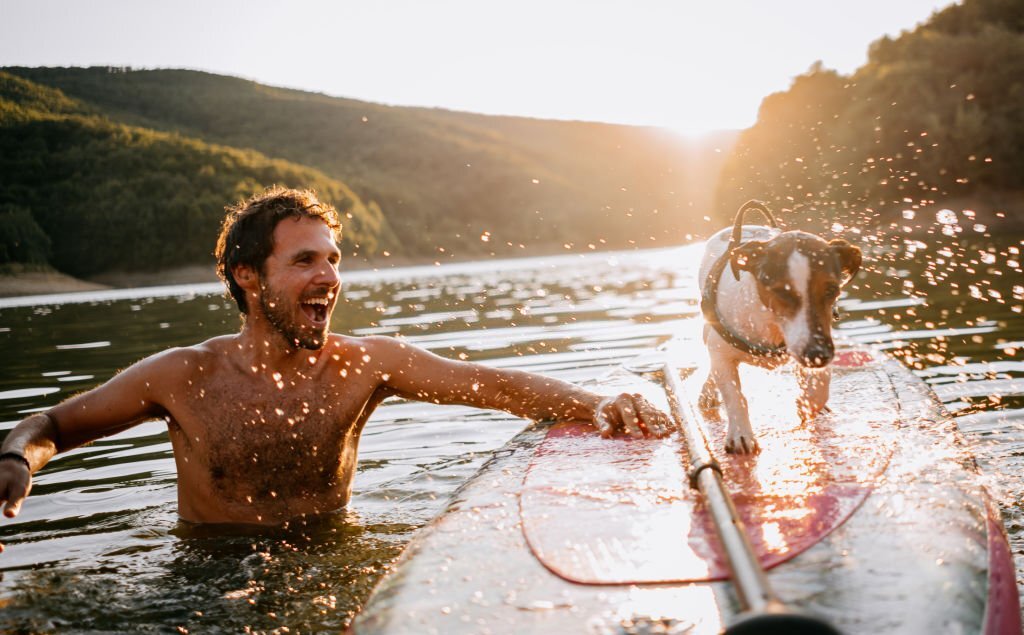
Step 8: Be Prepared for Jumps
Dogs may jump off the board unexpectedly. If this happens, help your dog get back onto the board to avoid any scratches or damage to the board’s finish. Life jackets designed for dogs often have handles to assist in lifting them back onto the board.
Step 9: Hydration is Key:
Remember to bring fresh water for both you and your dog. If you’re paddleboarding in saltwater, discourage your dog from drinking it as excessive consumption can lead to dehydration and health issues. Keep an eye out for any changes in mood or behavior, which could be early signs of salt poisoning.
Step 10: Patience is Everything:
Not all dogs take to paddleboarding immediately. If your dog seems hesitant or uncomfortable, don’t force the experience. Stay patient and understanding, and try to make each outing a positive and enjoyable one for both of you.
By following these steps and prioritizing safety, you can create wonderful memories while paddleboarding with your beloved canine companion. Enjoy the adventure and the special bond that forms as you both navigate the tranquil waters together.
ESSENTIAL SAFETY TIPS FOR EVERY PADDLEBOARD DOG
When preparing to SUP with your dog, safety should always be a top priority. Taking the necessary precautions ensures a secure and enjoyable experience for both you and your furry friend.
Carry a Portable First Aid Kit:
It’s always wise to be prepared for any unexpected situations. When planning longer paddleboarding sessions, bring along a portable first aid kit. This kit should include essential items for treating minor injuries and can also serve for temporary repairs to any torn or damaged equipment. Prioritizing safety allows you to focus on the fun and relaxation rather than worrying about potential injuries.

Where To Buy: Amazon
Why I Love It:
– Is fully packed over 100 different useful supplies that are great for you and your pup.
– It has a hard shell with a clip that can be attached to your paddleboard or left in your car.
– It’s also really small and protable so it’s great for travelling.
Protect Your Dog from Sunburn:
Dogs, like humans, are susceptible to sunburn, particularly on their bellies and areas with thin fur. Apply sunscreen to any exposed areas to protect your dog’s sensitive skin from harmful UV rays, especially when spending prolonged periods in direct sunlight. It’s also recommended to avoid extended exposure to the sun, limiting your paddleboarding sessions to a couple of hours at a time.
Where To Buy: Amazon
Why I Love It:
– Specially formulated to be soft for the sensitive skin of your pup (like the ears and belly that loves rubs)
– It will protect your best friend from head to toe.
– Its non-greasy without strong scents that will have your dog running for safety.
– It won the Emmy’s Best Pet Product award – only the best for your good boy/girl

Exercise Caution near Hazards:
Maintaining balance and stability on a paddleboard is crucial, especially when accompanied by your dog. To ensure both of your safety, kneel or sit on the board when near potential hazards such as docks, shallow water, boats, or crowded areas. Standing on the board is best reserved for open water to minimize the risk of accidents or injuries caused by sudden movements from your canine companion.
Rinse Your Dog After Paddleboarding:
Saltwater and sand can irritate your dog’s paws and skin. After your paddleboarding session, rinse off the sand and saltwater from your dog’s fur, paying particular attention to their ears. Leaving trapped water in the ears can lead to ear infections. Taking a few minutes to clean and rinse your dog will help prevent discomfort and potential health issues.
Stay Aware of Beach Hazards:
If paddleboarding in oceanic environments, be mindful of potential beach hazards. Sea lice can cause irritation to both you and your dog, while jellyfish pose a hazard in the water. Additionally, hot sand can burn your pups paws. When on the beach, try to keep your ooch in shaded areas or even in ankle-deep water to protect them from potential risks.
Please Don’t Leave Your Dog In The Car… EVER!

It’s a well-known safety rule, but it’s essential to reiterate: never leave your dog unattended in a vehicle, especially during warm weather. Heatstroke can occur within minutes, and the consequences can be severe. If you need to transport your dog, ensure they are with you in the car with windows open or the air conditioning on.
By following these safety tips, you can create a secure and enjoyable paddleboarding experience for you and your dog. Prioritize their well-being, and cherish the memorable moments spent together on the water.
Sometimes, unexpected challenges may arise during your paddleboarding journey with your dog.
If your dog shows signs of fear or anxiety, take it slow and provide reassurance. Gradually expose them to the water and board, rewarding positive behavior. In case of any unexpected situations like encountering wildlife or rough water, prioritize your dog’s safety and follow proper safety protocols.
Conclusion
Paddleboarding with your dog is a fantastic way to enjoy the outdoors and strengthen your bond. By following the steps outlined in this article, you’ll be well-prepared to embark on memorable adventures with your furry companion. Remember to prioritize safety, engage in activities that both you and your dog enjoy, and cherish the unique experiences you share on the water. If you’re driving or flying anywhere then make sure that you give your dog a safe flying experience… And most importantly enjoy!
| Looking for insider guides to some amazing paddle boarding locations? Check the Paddleboard Insiders Location Guides |
FAQs (Frequently Asked Questions)
Can any dog paddleboard, regardless of size?
Absolutely! Dogs of all sizes can enjoy paddleboarding. Just make sure to choose a paddleboard that can accommodate your dog’s weight and size for optimal stability.
What should I do if my dog falls off the paddleboard?
Stay calm and reassure your dog. Bring them back onto the board if they’re comfortable with it, or guide them to swim to the shore if necessary. Ensure they wear a life jacket for added safety.
Is it safe for my dog to drink the water while paddleboarding?
It’s best to discourage your dog from drinking the water, especially if it’s from a lake or river. Carry fresh water and a portable bowl for them to drink from during breaks.
How long can I paddleboard with my dog?
The duration of your paddleboarding sessions will depend on your dog’s stamina and comfort level. Start with shorter outings and gradually increase the time as your dog becomes more accustomed to it.
Can I paddleboard with multiple dogs at once?
While it’s possible to paddleboard with multiple dogs, it requires careful attention and experience. It’s recommended to start with one dog and gradually introduce additional dogs once you’re comfortable and confident in your abilities.
